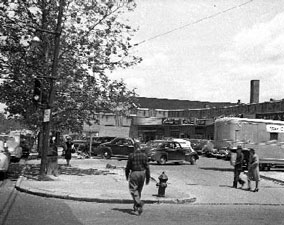Not another landmarked parking lot!
November’s HPRB meeting will consider landmark status for the Sheridan Theatre and Park and Shop, on Georgia Avenue in Brightwood. The DC Preservation League named the Sheridan one of its most endangered properties in 2007. This 1937 Art Deco community theater is now a dollar store; it was built a year before Silver Spring’s Silver Theatre, which was recently restored and now houses the American Film Institute.
It doesn’t look like much from the picture above, but I believe the DCPL when they say this is worth preserving. The HPRB agenda, though, also mentions the Park and Shop. Just like in Silver Spring, this Art Deco theatre sits next to an Art Deco strip mall with a parking lot in front.
These old strip malls are one of the the clearest points of conflict between preservation and planning. Open parking lots right at the sidewalk are the worst land use from a pedestrian standpoint; they not only kill the street, but contribute to a car-centric feel. It’s true that they represent an important period in our history, but a period where planners were essentially trying to kill cities as we knew them and turn them into suburbs. We now recognize that as our cities’ greatest mistake.
Encasing these urban poison pills in preservation amber is like landmarking a toxic waste site next to a school playground and declaring that it may never be cleaned up, to continually remind us of a historic period where many nearby children died of leukemia. Brightwood is a community on the edge of economic resurgence, and Georgia’s commercial strip a “Great Street” with much potential. We must give Brightwood every opportunity to become a vibrant and walkable neighborhood, not foist suburban-style pollution on one of its corners in perpetuity.
Besides, we already have several landmarked Park and Shops. In addition to the one in Silver Spring, we have Cleveland Park’s Park and Shop surrounding the Metro entrance. That was built in 1930, seven years before the Brightwood Park and Shop. And Cleveland Park’s is already historically protected. Therefore, we have an even more influential early example of a suburban strip mall in the city, and a much better preserved Art Deco one, both in areas much more likely to be “enjoyed” by many people. Therefore, we don’t need to keep this one.
If I’m parsing the above image right, protecting the Sheridan doesn’t require also landmarking the Park and Shop. The Sheridan is the building with the peaked roof on the left, while the Park and Shop is on the right. HPRB should therefore go ahead with landmarking the Sheridan, but let the Park and Shop one day become a taller, mixed-use project to bring life to the corner—and potential patrons to a Sheridan hopefully returned to its historic use as a community theater.



